
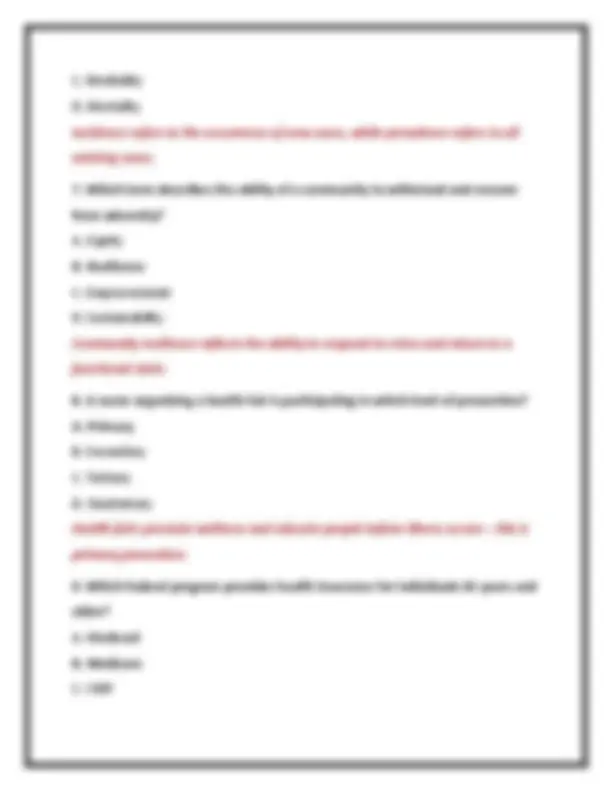
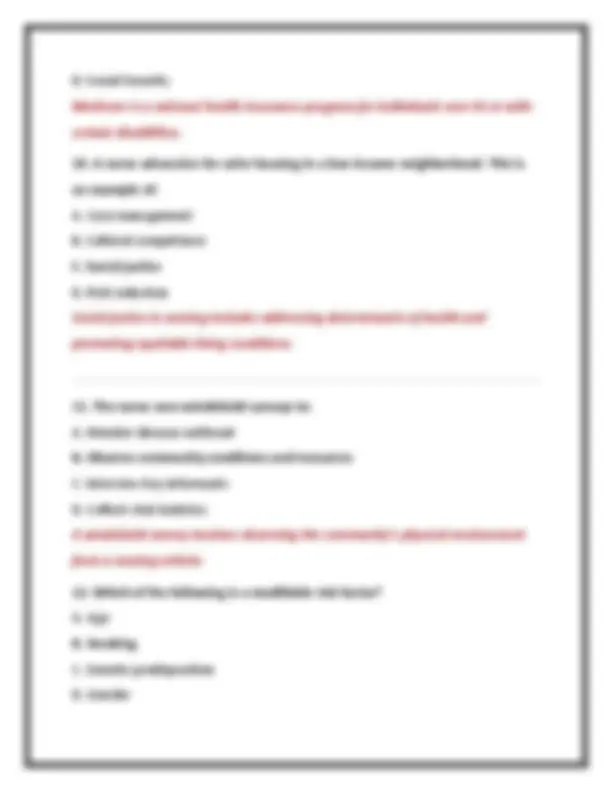
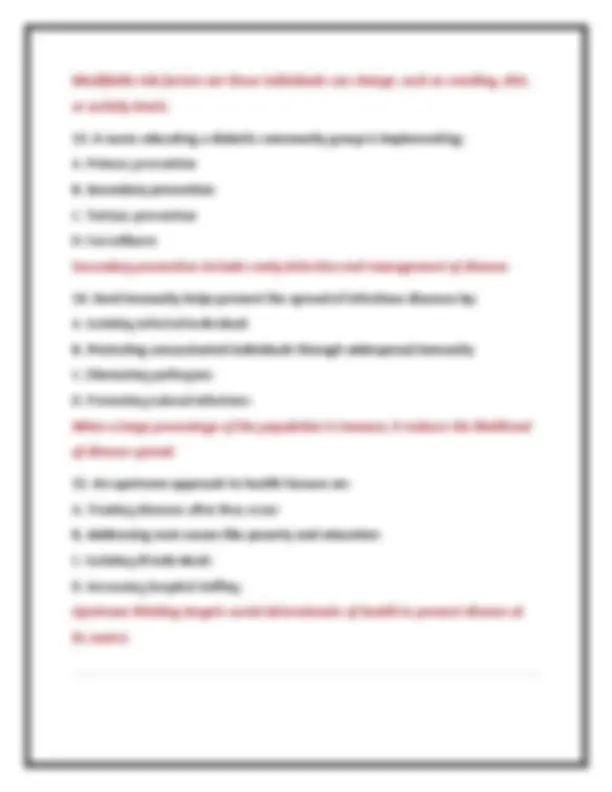
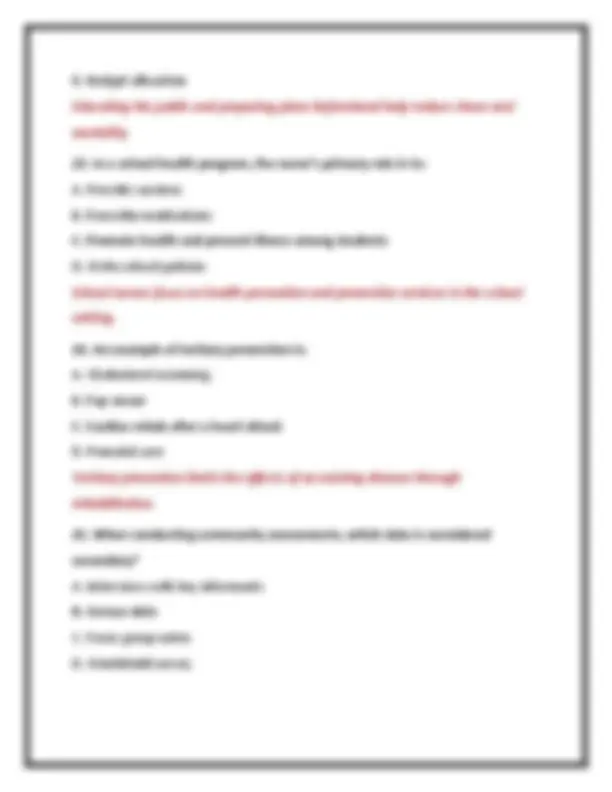
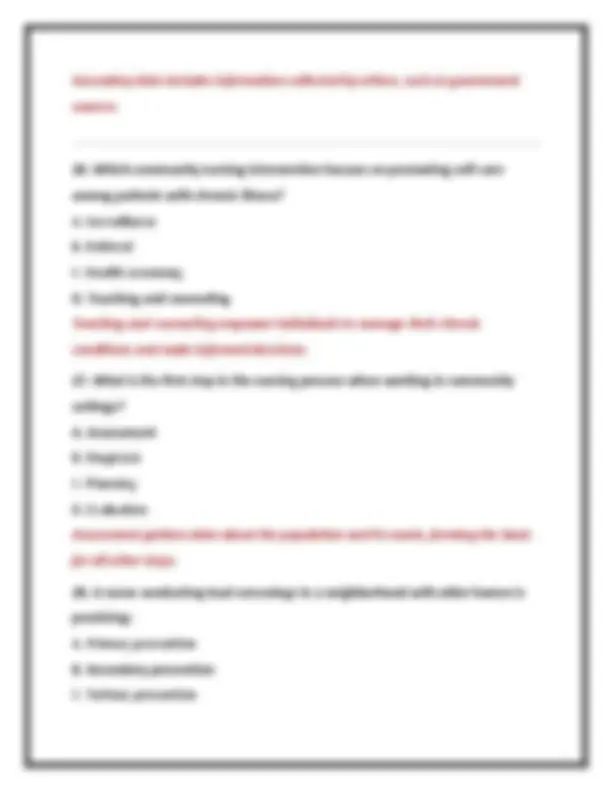
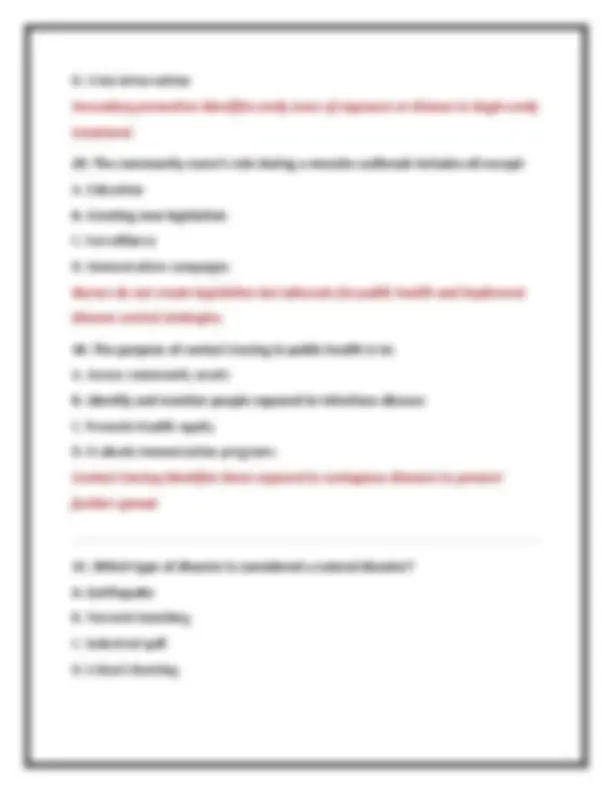
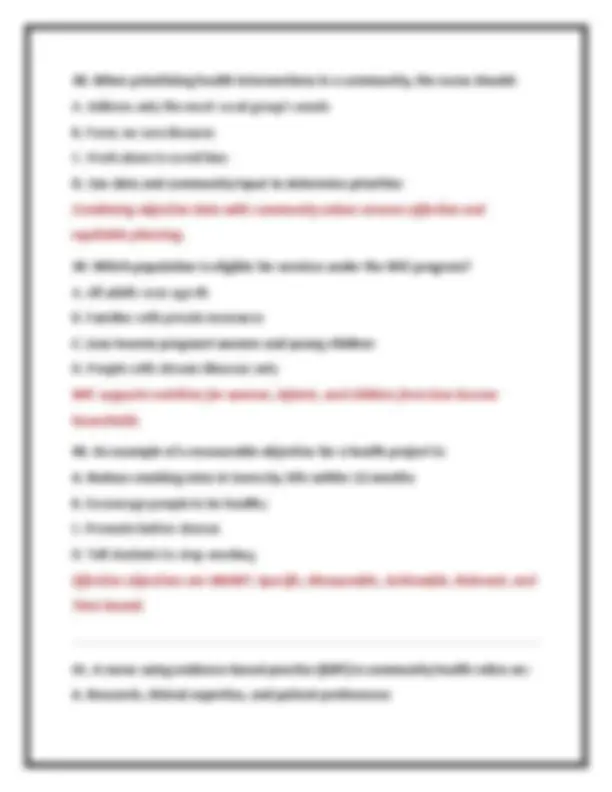
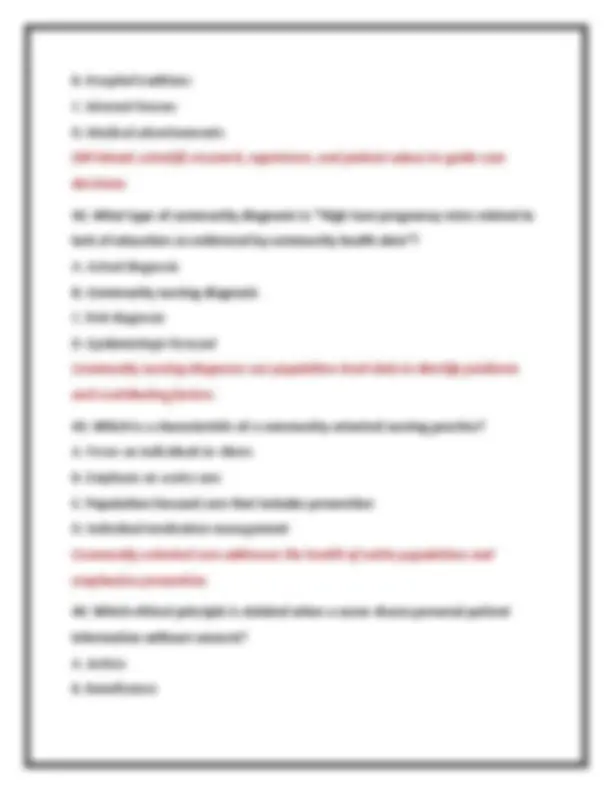
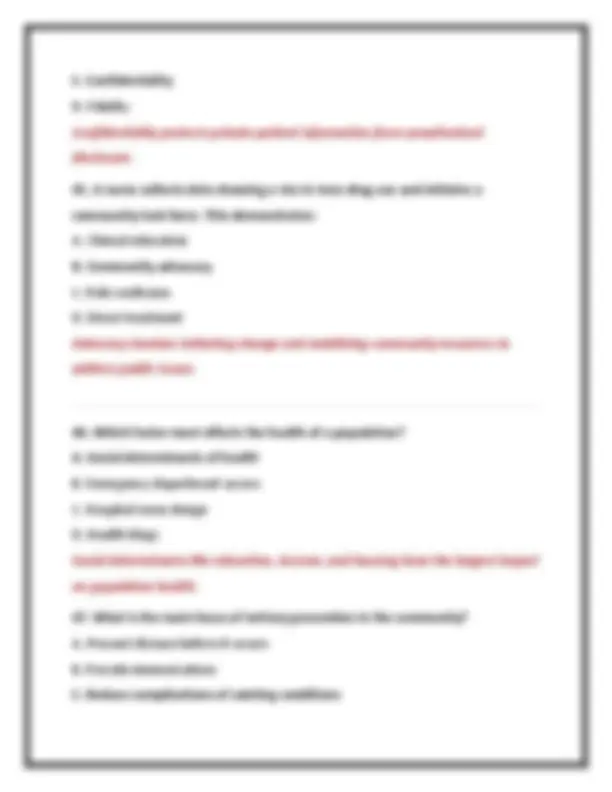
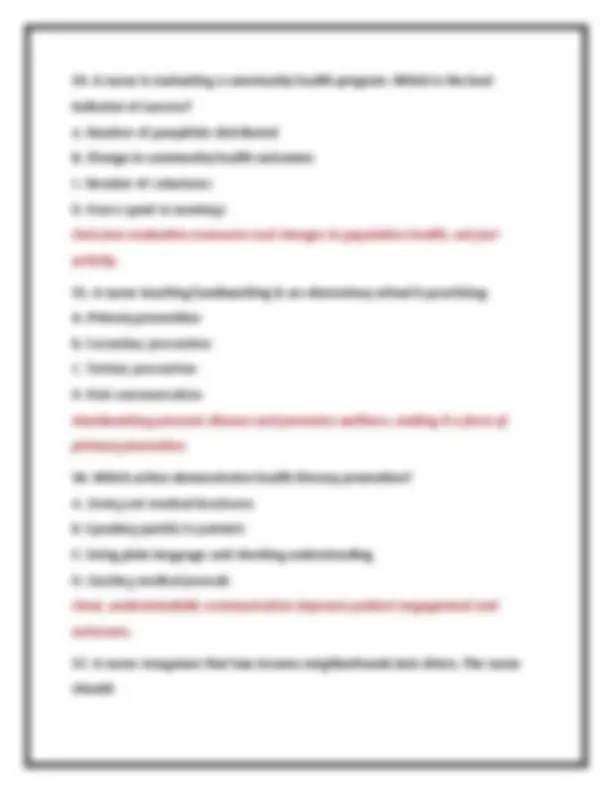
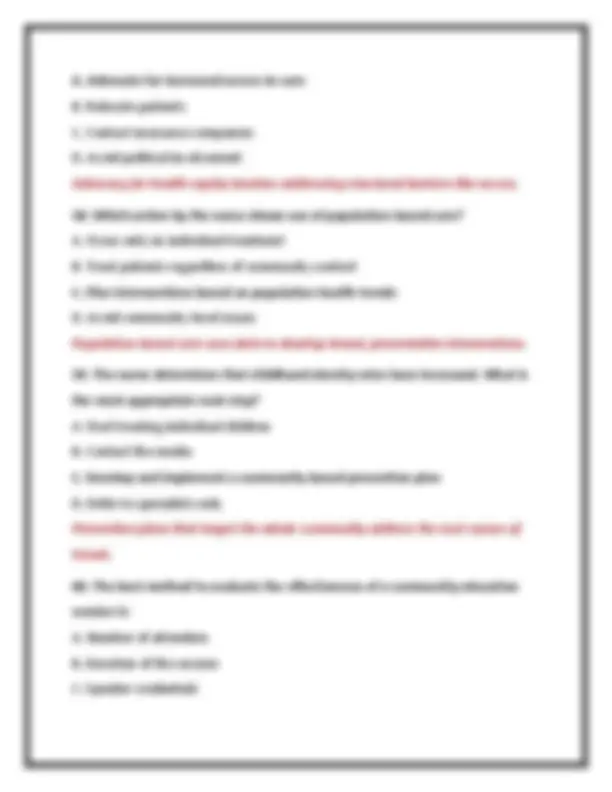
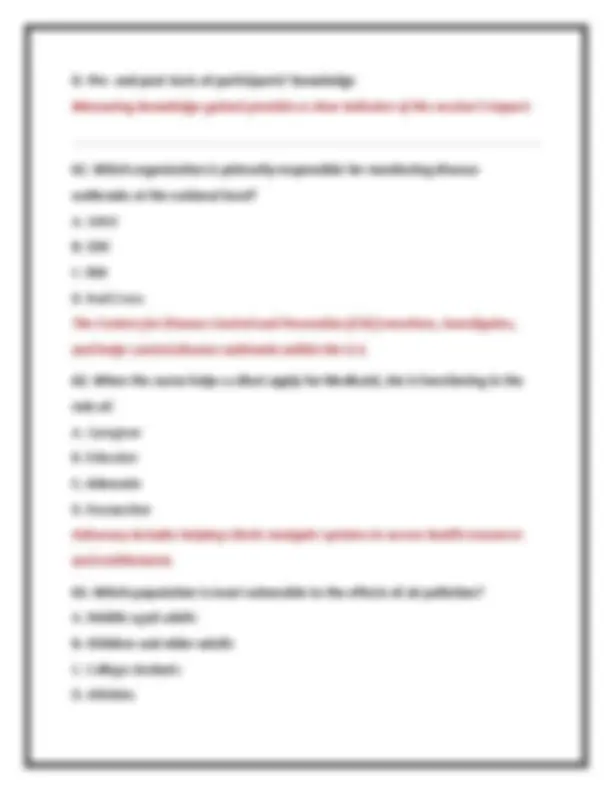
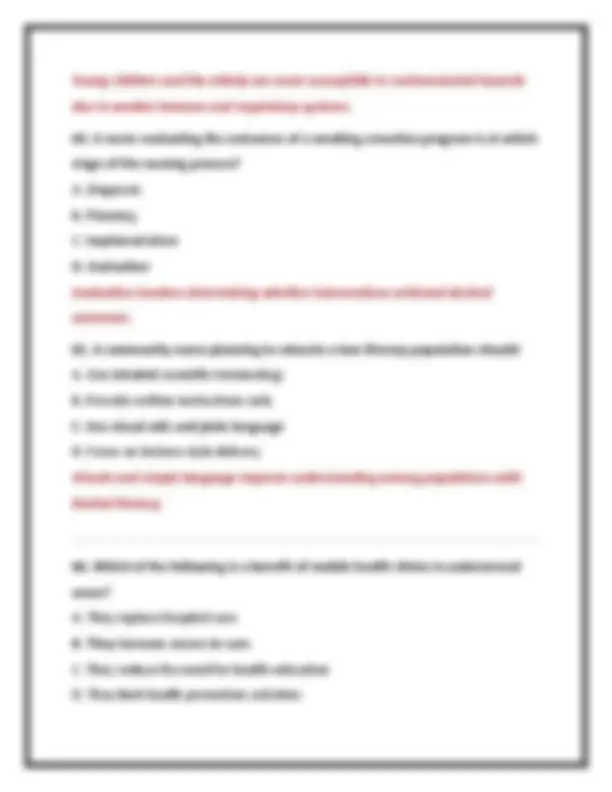
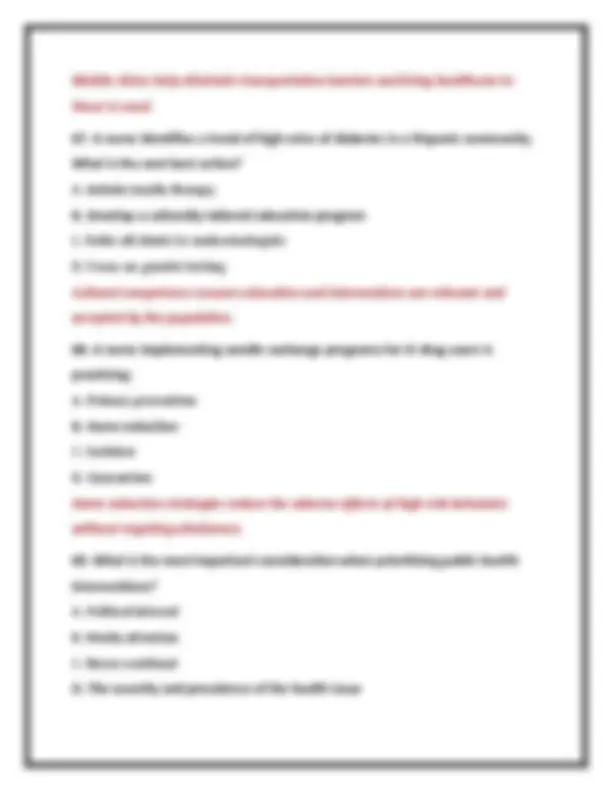
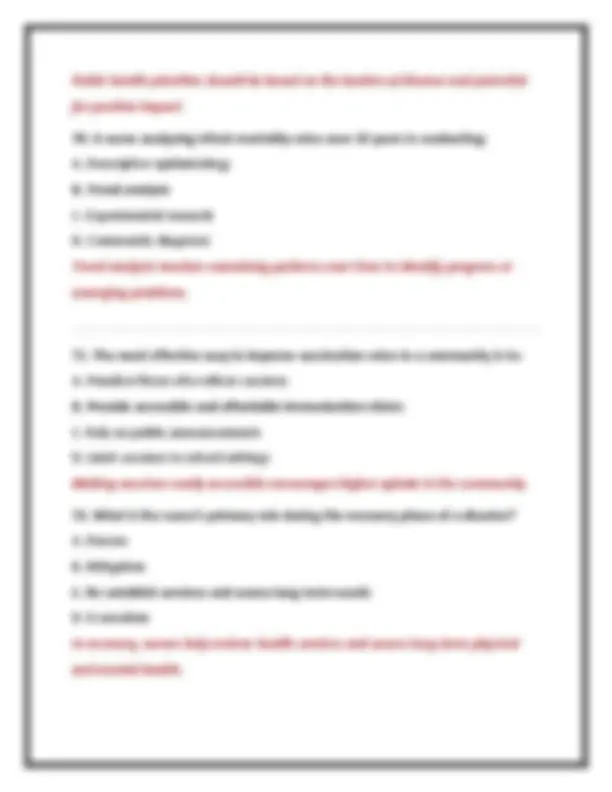
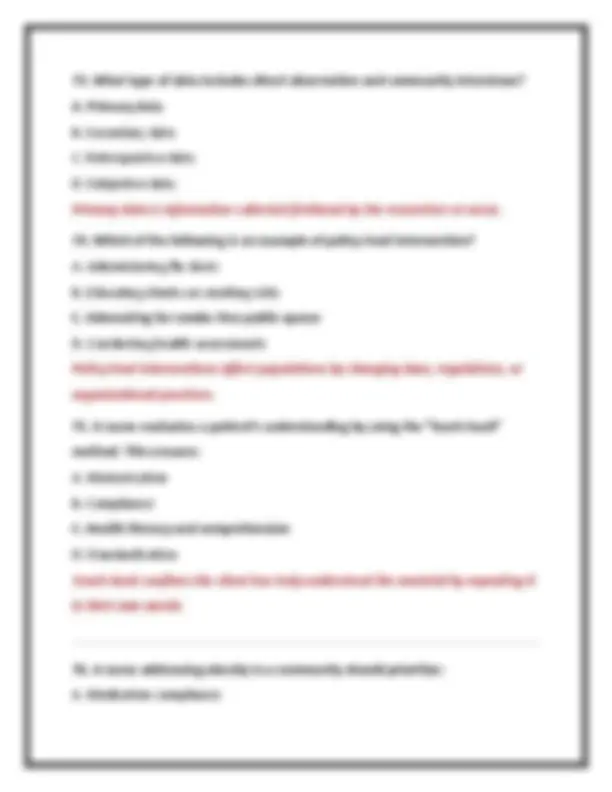
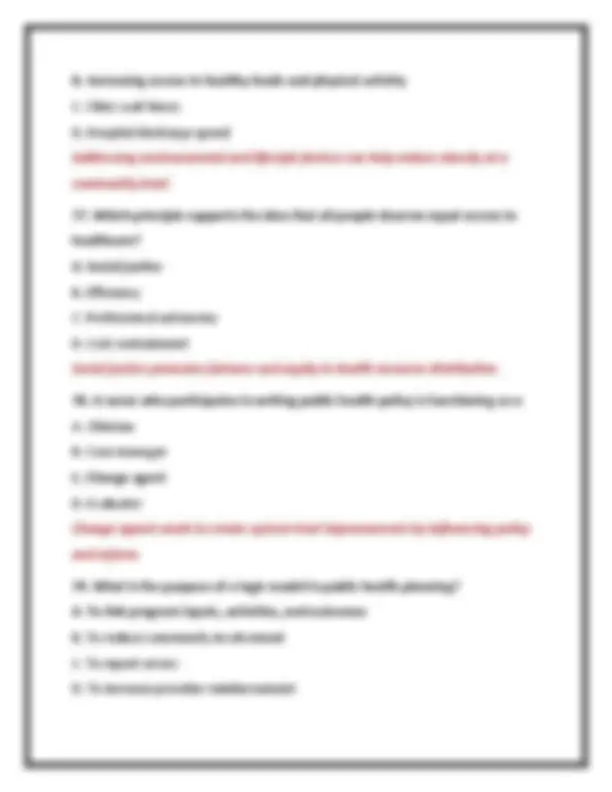
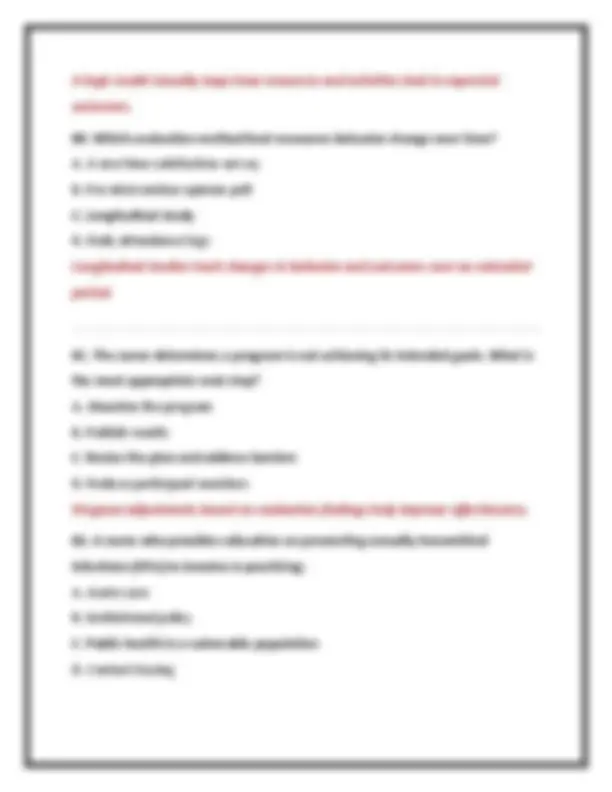
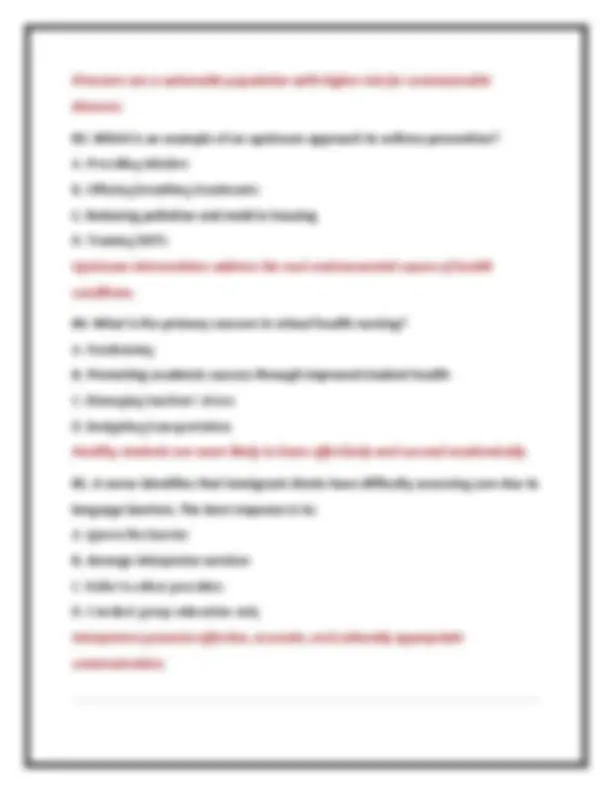
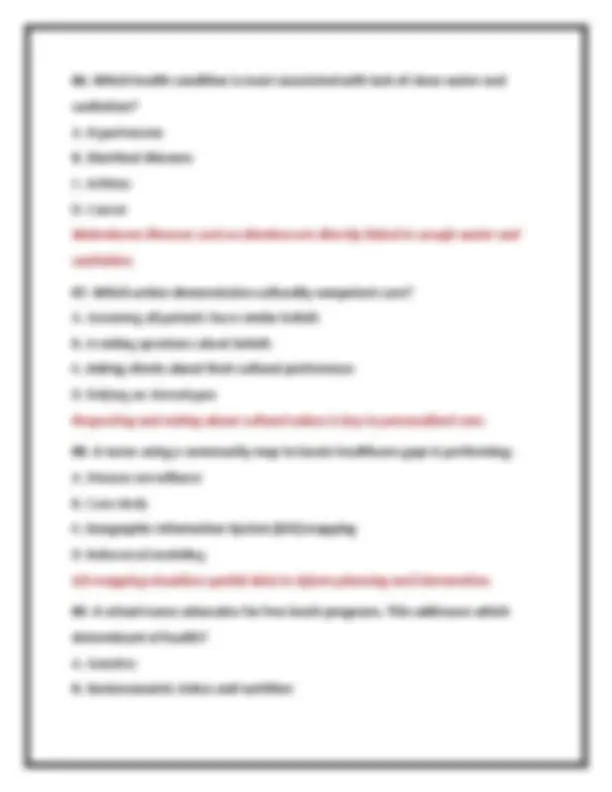
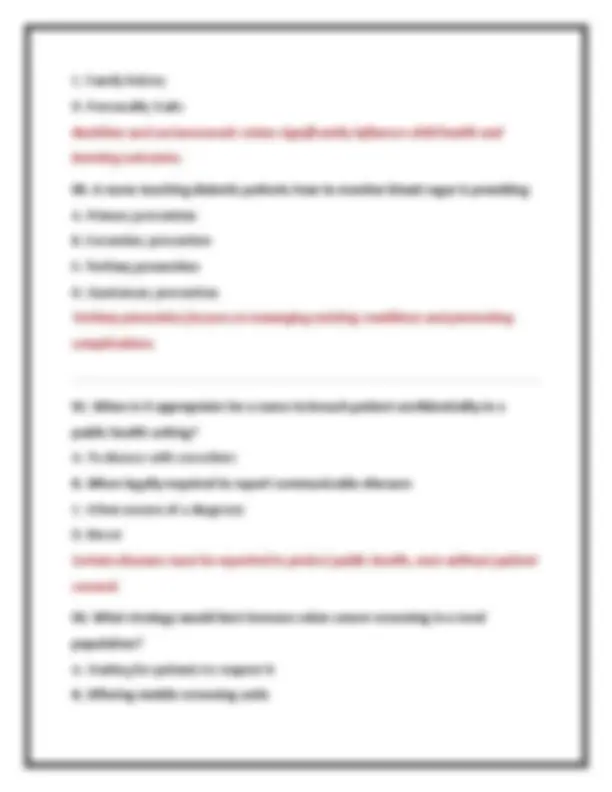
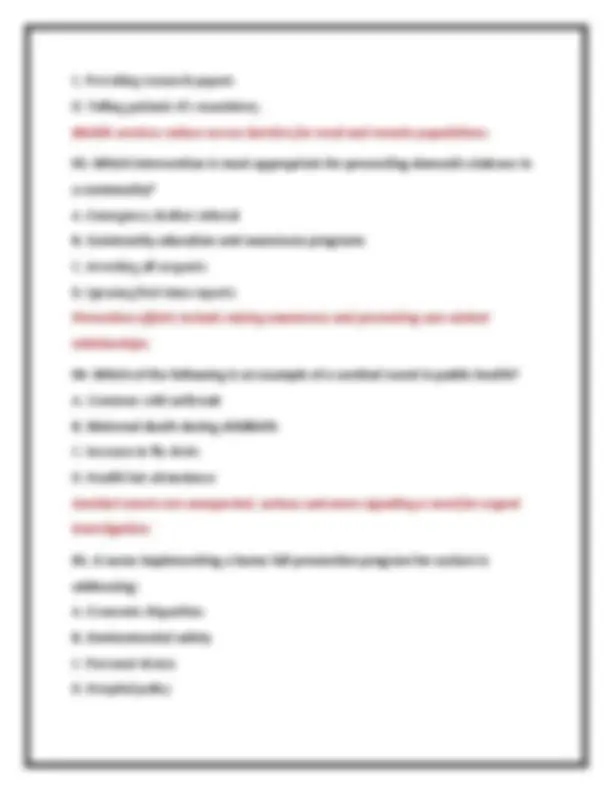
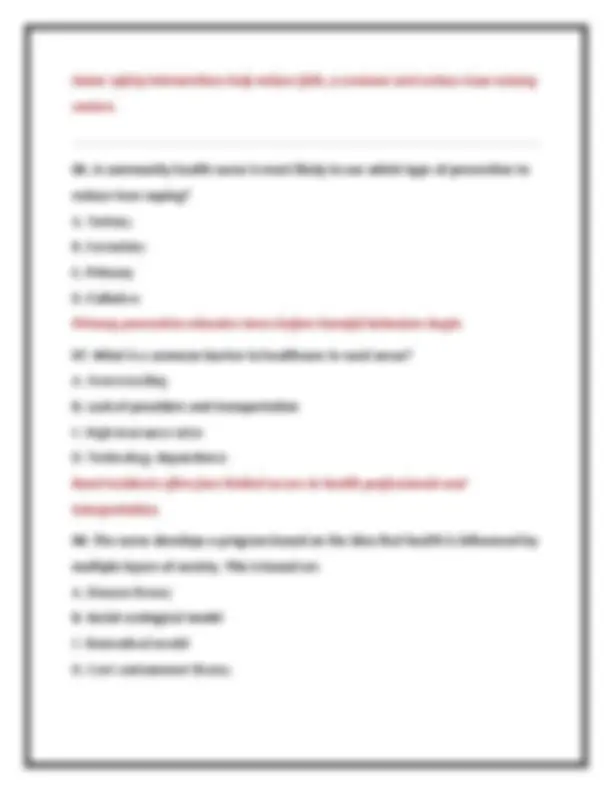
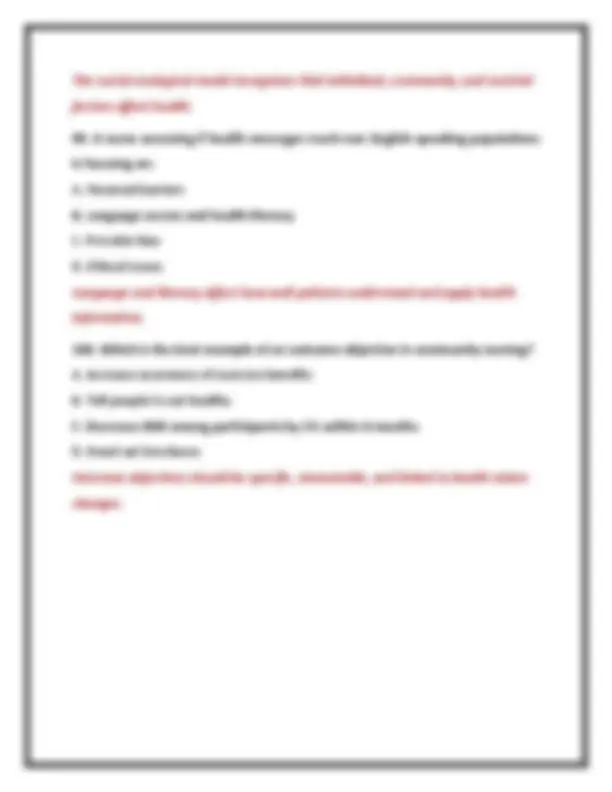


Study with the several resources on Docsity

Earn points by helping other students or get them with a premium plan


Prepare for your exams
Study with the several resources on Docsity

Earn points to download
Earn points by helping other students or get them with a premium plan
Community
Ask the community for help and clear up your study doubts
Discover the best universities in your country according to Docsity users
Free resources
Download our free guides on studying techniques, anxiety management strategies, and thesis advice from Docsity tutors
NSG 4533 Community Nursing (RN-to-BSN Final Project) Exam Questions And Correct Answers (Verified Answers) Plus Rationales 2025 Q&A | Instant Download PDF This exam includes key topics such as population health, epidemiology, vulnerable populations, health policy, and community assessment.
Typology: Exams
1 / 32

This page cannot be seen from the preview
Don't miss anything!

























This exam includes key topics such as population health, epidemiology, vulnerable populations, health policy, and community assessment.
1. Which of the following best describes the focus of community health nursing? A. Providing direct care to individuals in acute care settings B. Diagnosing and treating chronic illnesses C. Promoting health and preventing disease in populations D. Managing medication therapy in clinics Community health nursing aims to improve health outcomes for groups and populations by emphasizing prevention and health promotion. 2. A nurse is assessing the needs of a community. Which tool is most appropriate to identify community strengths and weaknesses? A. Nursing diagnosis B. Community health assessment C. SWOT analysis D. Strategic plan A community health assessment systematically collects data to understand the health status, resources, and needs of the community.
3. The primary role of the community health nurse in health promotion is to: A. Administer medications B. Educate and empower individuals and groups C. Perform physical examinations D. Provide long-term care Health promotion involves increasing awareness and enabling people to make informed choices about their health. 4. Which epidemiological triangle element includes the person or population affected by a disease? A. Environment B. Agent C. Host D. Vector The host is the individual or group exposed to the disease or health condition. 5. Which of the following is an example of a primary prevention strategy? A. Mammogram screening B. Medication adherence education C. Immunization clinic D. Rehabilitation after stroke Primary prevention aims to prevent disease before it occurs, such as through vaccinations. 6. The number of new cases of a disease in a specific time period is known as: A. Prevalence B. Incidence
D. Social Security Medicare is a national health insurance program for individuals over 65 or with certain disabilities.
10. A nurse advocates for safer housing in a low-income neighborhood. This is an example of: A. Case management B. Cultural competence C. Social justice D. Risk reduction Social justice in nursing includes addressing determinants of health and promoting equitable living conditions. 11. The nurse uses windshield surveys to: A. Monitor disease outbreak B. Observe community conditions and resources C. Interview key informants D. Collect vital statistics A windshield survey involves observing the community’s physical environment from a moving vehicle. 12. Which of the following is a modifiable risk factor? A. Age B. Smoking C. Genetic predisposition D. Gender
Modifiable risk factors are those individuals can change, such as smoking, diet, or activity levels.
13. A nurse educating a diabetic community group is implementing: A. Primary prevention B. Secondary prevention C. Tertiary prevention D. Surveillance Secondary prevention includes early detection and management of disease. 14. Herd immunity helps prevent the spread of infectious diseases by: A. Isolating infected individuals B. Protecting unvaccinated individuals through widespread immunity C. Eliminating pathogens D. Promoting natural infections When a large percentage of the population is immune, it reduces the likelihood of disease spread. 15. An upstream approach to health focuses on: A. Treating diseases after they occur B. Addressing root causes like poverty and education C. Isolating ill individuals D. Increasing hospital staffing Upstream thinking targets social determinants of health to prevent disease at its source.
C. Educational level D. Immunization status Social determinants include the conditions where people live, learn, and work— education is one.
20. The Healthy People 2030 initiative focuses on: A. Promoting health and reducing health disparities B. Expanding hospital infrastructure C. Reducing taxes on healthcare D. Supporting international aid Healthy People 2030 provides national objectives to improve the health and well-being of Americans. 21. A nurse reporting a suspected case of tuberculosis is following which principle? A. Public health surveillance B. Case management C. Privacy regulations D. Disease treatment Surveillance involves ongoing data collection and reporting of communicable diseases. 22. The most important aspect of disaster preparedness is: A. Medical stockpiling B. Community education and planning C. Volunteer recruitment
D. Budget allocation Educating the public and preparing plans beforehand help reduce chaos and mortality.
23. In a school health program, the nurse’s primary role is to: A. Provide vaccines B. Prescribe medications C. Promote health and prevent illness among students D. Write school policies School nurses focus on health promotion and preventive services in the school setting. 24. An example of tertiary prevention is: A. Cholesterol screening B. Pap smear C. Cardiac rehab after a heart attack D. Prenatal care Tertiary prevention limits the effects of an existing disease through rehabilitation. 25. When conducting community assessments, which data is considered secondary? A. Interviews with key informants B. Census data C. Focus group notes D. Windshield survey
D. Crisis intervention Secondary prevention identifies early cases of exposure or disease to begin early treatment.
29. The community nurse’s role during a measles outbreak includes all except: A. Education B. Creating new legislation C. Surveillance D. Immunization campaigns Nurses do not create legislation but advocate for public health and implement disease control strategies. 30. The purpose of contact tracing in public health is to: A. Assess community assets B. Identify and monitor people exposed to infectious disease C. Promote health equity D. Evaluate immunization programs Contact tracing identifies those exposed to contagious diseases to prevent further spread. 31. Which type of disaster is considered a natural disaster? A. Earthquake B. Terrorist bombing C. Industrial spill D. School shooting
Natural disasters include events like earthquakes, floods, or hurricanes—non- human-caused.
32. The goal of occupational health nursing is to: A. Manage employee insurance B. Promote health and prevent injury in the workplace C. Provide hospital care D. Reduce malpractice risk Occupational health focuses on creating safe and healthy work environments. 33. A community nurse is teaching safe sex practices to adolescents. This is an example of: A. Tertiary prevention B. Surveillance C. Primary prevention D. Direct observation Safe sex education prevents the occurrence of sexually transmitted infections. 34. The nurse identifies increased asthma cases in a community near a manufacturing plant. What is the next step? A. Refer clients to pulmonologists B. Report it to school boards C. Request funding for new clinics D. Conduct an environmental health assessment Environmental assessments help determine links between pollutants and health outcomes.
38. When prioritizing health interventions in a community, the nurse should: A. Address only the most vocal group's needs B. Focus on rare diseases C. Work alone to avoid bias D. Use data and community input to determine priorities Combining objective data with community values ensures effective and equitable planning. 39. Which population is eligible for services under the WIC program? A. All adults over age 65 B. Families with private insurance C. Low-income pregnant women and young children D. People with chronic illnesses only WIC supports nutrition for women, infants, and children from low-income households. 40. An example of a measurable objective for a health project is: A. Reduce smoking rates in teens by 10% within 12 months B. Encourage people to be healthy C. Promote better choices D. Tell students to stop smoking Effective objectives are SMART: Specific, Measurable, Achievable, Relevant, and Time-bound. 41. A nurse using evidence-based practice (EBP) in community health relies on: A. Research, clinical expertise, and patient preferences
B. Hospital traditions C. Internet forums D. Medical advertisements EBP blends scientific research, experience, and patient values to guide care decisions.
42. What type of community diagnosis is: “High teen pregnancy rates related to lack of education as evidenced by community health data”? A. Actual diagnosis B. Community nursing diagnosis C. Risk diagnosis D. Epidemiologic forecast Community nursing diagnoses use population-level data to identify problems and contributing factors. 43. Which is a characteristic of a community-oriented nursing practice? A. Focus on individuals in clinics B. Emphasis on acute care C. Population-focused care that includes prevention D. Individual medication management Community-oriented care addresses the health of entire populations and emphasizes prevention. 44. Which ethical principle is violated when a nurse shares personal patient information without consent? A. Justice B. Beneficence
D. Offer community health fairs Tertiary prevention reduces the impact of disease by managing symptoms and improving quality of life.
48. During a home visit, a nurse notes unsafe wiring in a client’s house. The best next action is to: A. Report the client to adult protective services B. Refer the client to housing assistance services C. Ignore the issue D. Call law enforcement Community nurses can connect clients to resources that address environmental health risks. 49. A nurse measuring BMI trends across school districts is collecting: A. Aggregate data B. Anecdotal data C. Experimental data D. Personal opinions Aggregate data reflects population-level information used for analysis and intervention planning. 50. The nurse developing a teaching plan about hygiene for a homeless shelter is engaging in: A. Tertiary prevention B. Surveillance C. Primary prevention D. Diagnostic services
Educating about hygiene prevents illness before it occurs, which is primary prevention. 51. The nurse collaborates with faith leaders in a community health initiative. This shows: A. Government overreach B. Policy violation C. Community partnership D. Scope-of-practice breach Community partnerships are essential for building trust and reaching diverse populations.
52. A nurse planning interventions for an elderly community should first consider: A. Language preferences B. Travel distances C. Functional status and mobility D. Recreational habits Elderly individuals may face physical limitations that affect access to services. 53. Involving residents in solving their own health issues promotes: A. Empowerment B. Dependency C. Surveillance D. Fragmentation Empowerment encourages ownership and sustainable health improvements.
A. Advocate for increased access to care B. Relocate patients C. Contact insurance companies D. Avoid political involvement Advocacy for health equity involves addressing structural barriers like access.
58. Which action by the nurse shows use of population-based care? A. Focus only on individual treatment B. Treat patients regardless of community context C. Plan interventions based on population health trends D. Avoid community-level issues Population-based care uses data to develop broad, preventative interventions. 59. The nurse determines that childhood obesity rates have increased. What is the most appropriate next step? A. Start treating individual children B. Contact the media C. Develop and implement a community-based prevention plan D. Refer to specialists only Prevention plans that target the whole community address the root causes of trends. 60. The best method to evaluate the effectiveness of a community education session is: A. Number of attendees B. Duration of the session C. Speaker credentials
D. Pre- and post-tests of participants' knowledge Measuring knowledge gained provides a clear indicator of the session's impact.
61. Which organization is primarily responsible for monitoring disease outbreaks at the national level? A. WHO B. CDC C. NIH D. Red Cross The Centers for Disease Control and Prevention (CDC) monitors, investigates, and helps control disease outbreaks within the U.S. 62. When the nurse helps a client apply for Medicaid, she is functioning in the role of: A. Caregiver B. Educator C. Advocate D. Researcher Advocacy includes helping clients navigate systems to access health resources and entitlements. 63. Which population is most vulnerable to the effects of air pollution? A. Middle-aged adults B. Children and older adults C. College students D. Athletes